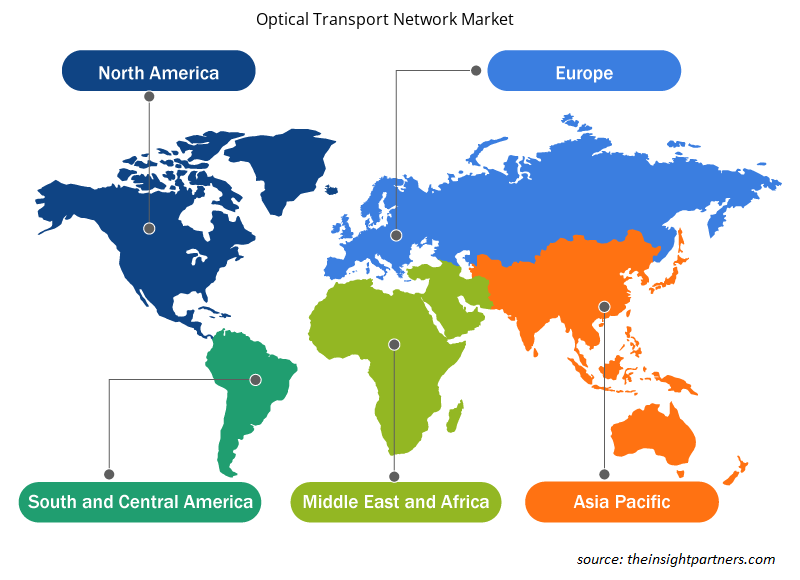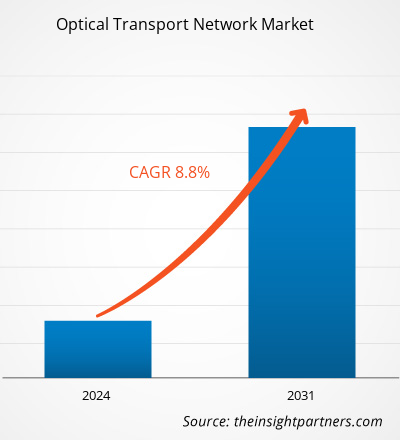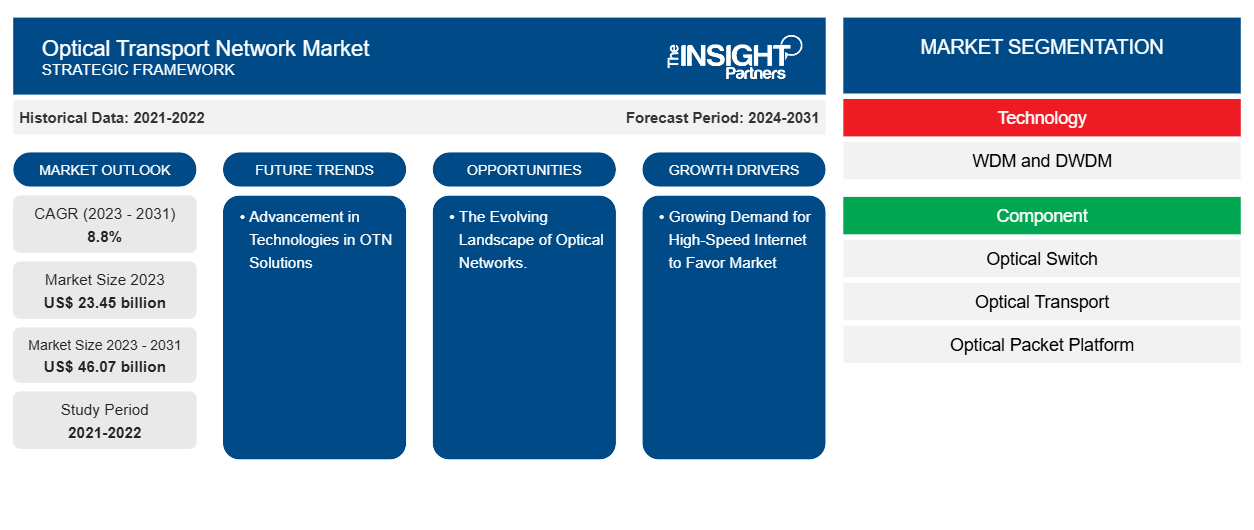光传输网络市场规模预计将从 2023 年的 234.5 亿美元增至 2031 年的 460.7 亿美元。预计 2023-2031 年市场复合年增长率将达到 8.8%。随着互联网网络的改善和 OTN 解决方案提供商的技术进步,对更大带宽的需求不断增加,这可能仍是光传输网络市场的一个关键趋势。
光传输网市场分析
由于住宅和办公室互联网用户的急剧增加,目前对网络容量的需求也越来越大。预计研究市场的需求将受到社交网络、视频会议、在线游戏和其他实时流媒体活动的日益普及的推动。光传输网络最大限度地减少延迟并提供无缝数据传输是推动市场增长的主要因素之一。
光传输网络市场概览
光传输网络 (OTN) 使用光纤在节点之间传输数据,是一种分层的分级网络。数字封装器(例如下一代行业标准 OTN)提供了一种将不同服务复用到光路中的便捷快速的方法。它是通过光纤连接的光网络元件的集合,能够传输、复用、交换、控制、监控和维护传输客户端信号的光通道的运行。
定制此报告以满足您的需求
您可以免费定制任何报告,包括本报告的部分内容、国家级分析、Excel 数据包,以及为初创企业和大学提供优惠和折扣
-
获取此报告的关键市场趋势。这个免费样品将包括数据分析,从市场趋势到估计和预测。
光传输网络市场驱动因素和机遇
高速互联网需求不断增长,市场前景看好
互联网普及的需求也受到城市化程度的影响。由于这些进步,越来越多的人正在使用互联网,这有利于市场的增长。此外,智慧城市的概念正在推动对高速互联网的需求。智慧城市基础设施的一个基本要素是物联网,它将公共、商业和个人领域的众多设备连接起来——从手机到可穿戴设备。
光纤网络的不断发展。
光纤网络环境正在迅速变化,预计未来几年将大幅扩展。尽管管理光纤传输存在挑战,但疫情凸显了虚拟网络对于娱乐以及远程学习和居家办公的重要性。预计未来几年,所有网络类别都将大幅增长。网络边缘连接到住宅宽带,城域网紧随数据中心连接之后。
光传输网络市场报告细分分析
有助于得出光传输网络市场分析的关键部分是技术、组件、服务和最终用途。
- 根据技术,光传输网市场分为 WDM 和 DWDM。WDM 部分预计在预测期内将会增长。
- 根据组件,市场分为光开关、光传输和光分组平台。光开关部分预计在预测期内增长。
- 根据服务,光传输网络市场分为网络设计和网络维护与支持。网络设计部分预计在预测期内将实现增长。
- 从终端用户角度来看,市场分为通信服务提供商、企业和政府。预计通信服务提供商部分在预测期内将大幅增长。
光传输网络市场份额(按地区)分析
光传输网络市场报告的地理范围主要分为五个区域:北美、亚太地区、欧洲、中东和非洲以及南美/南美和中美洲。北美在光传输网络市场占据主导地位。北美地区各行业的高科技采用趋势推动了光传输网络市场的增长。数字工具的采用率提高和政府机构在技术方面的高支出等因素预计将推动北美光传输网络市场的增长。此外,美国和加拿大等发达经济体高度重视研发,这迫使北美参与者将技术先进的解决方案引入市场。此外,美国拥有大量光传输网络市场参与者,他们越来越注重开发创新解决方案。所有这些因素都促进了该地区光传输网络市场的增长。
光传输网络市场报告范围
光传输网络市场区域洞察
Insight Partners 的分析师已详细解释了预测期内影响光传输网络市场的区域趋势和因素。本节还讨论了北美、欧洲、亚太地区、中东和非洲以及南美和中美洲的光传输网络市场细分和地理位置。

- 获取光传输网络市场的区域特定数据
光传输网络市场报告范围
| 报告属性 | 细节 |
|---|---|
| 2023 年的市场规模 | 234.5亿美元 |
| 2031 年市场规模 | 460.7亿美元 |
| 全球复合年增长率(2023 - 2031) | 8.8% |
| 史料 | 2021-2022 |
| 预测期 | 2024-2031 |
| 涵盖的领域 |
按技术分类
|
| 覆盖地区和国家 |
北美
|
| 市场领导者和主要公司简介 |
|
市场参与者密度:了解其对商业动态的影响
光传输网络市场正在快速增长,这得益于终端用户需求的不断增长,而这些需求又源于消费者偏好的不断变化、技术进步以及对产品优势的认识不断提高等因素。随着需求的增加,企业正在扩大其产品范围,进行创新以满足消费者的需求,并利用新兴趋势,从而进一步推动市场增长。
市场参与者密度是指在特定市场或行业内运营的企业或公司的分布情况。它表明相对于给定市场空间的规模或总市场价值,有多少竞争对手(市场参与者)存在于该市场空间中。
在光传输网络市场运营的主要公司有:
- 富士通
- 华为技术有限公司
- 中兴通讯
- 思科系统公司
- ALE 国际
- Adtran 网络
免责声明:上面列出的公司没有按照任何特定顺序排列。

- 了解光传输网络市场顶级关键参与者概况
光传输网络市场新闻和最新发展
光传输网络市场通过收集一手和二手研究后的定性和定量数据进行评估,其中包括重要的公司出版物、协会数据和数据库。以下是市场发展情况的列表:
- 2024 年 3 月,Transworld Associates (TWA) 将使用诺基亚的光传输解决方案构建连接巴基斯坦、阿拉伯联合酋长国 (UAE) 和阿曼的新光网络,作为其海底容量扩展计划的一部分。卡拉奇地铁也正在部署海底容量回程系统。该项目将通过适应数据中心之间数据和带宽链路的指数增长来支持该地区的转型。
(来源:诺基亚,新闻稿,2024 年)
- 2023 年 11 月,诺基亚与 Bharti Airtel 合作部署光纤传输网络,以满足印度 SG 领域日益增长的需求。此次合作将为 Airtel 提供增强的容量和可靠性,从而为其客户提供更好的服务。Airtel 将利用诺基亚的 OTN 交换机升级其传输交换基础设施,并提高整体容量和带宽效率。
(来源:Aptean,新闻稿,2022 年)
光传输网络市场报告覆盖范围和交付成果
“光传输网络市场规模和预测(2021-2031)”报告对以下领域进行了详细的市场分析:
- 范围内涵盖的所有主要细分市场的全球、区域和国家层面的市场规模和预测
- 市场动态,如驱动因素、限制因素和关键机遇
- 未来主要趋势
- 详细的 PEST/波特五力分析和 SWOT 分析
- 全球和区域市场分析涵盖关键市场趋势、主要参与者、法规和最新市场发展
- 行业格局和竞争分析,涵盖市场集中度、热点图分析、知名参与者和最新发展
- 详细的公司简介
- 历史分析(2 年)、基准年、预测(7 年)及复合年增长率
- PEST和SWOT分析
- 市场规模、价值/数量 - 全球、区域、国家
- 行业和竞争格局
- Excel 数据集
近期报告
客户评价
购买理由
- 明智的决策
- 了解市场动态
- 竞争分析
- 客户洞察
- 市场预测
- 风险规避
- 战略规划
- 投资论证
- 识别新兴市场
- 优化营销策略
- 提升运营效率
- 顺应监管趋势























 获取免费样品 - 光传输网络市场
获取免费样品 - 光传输网络市场